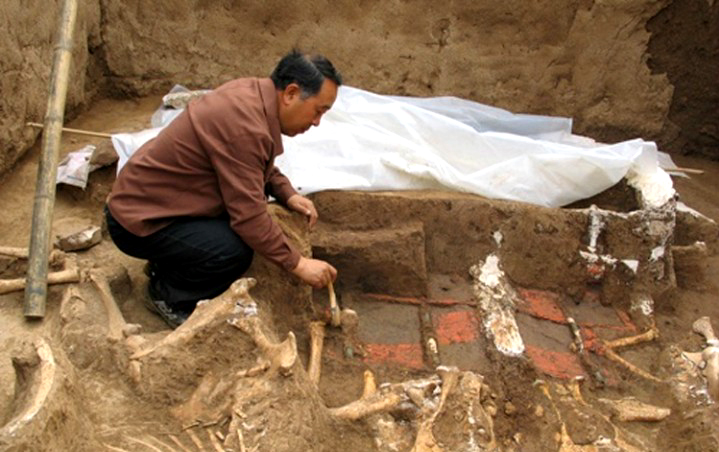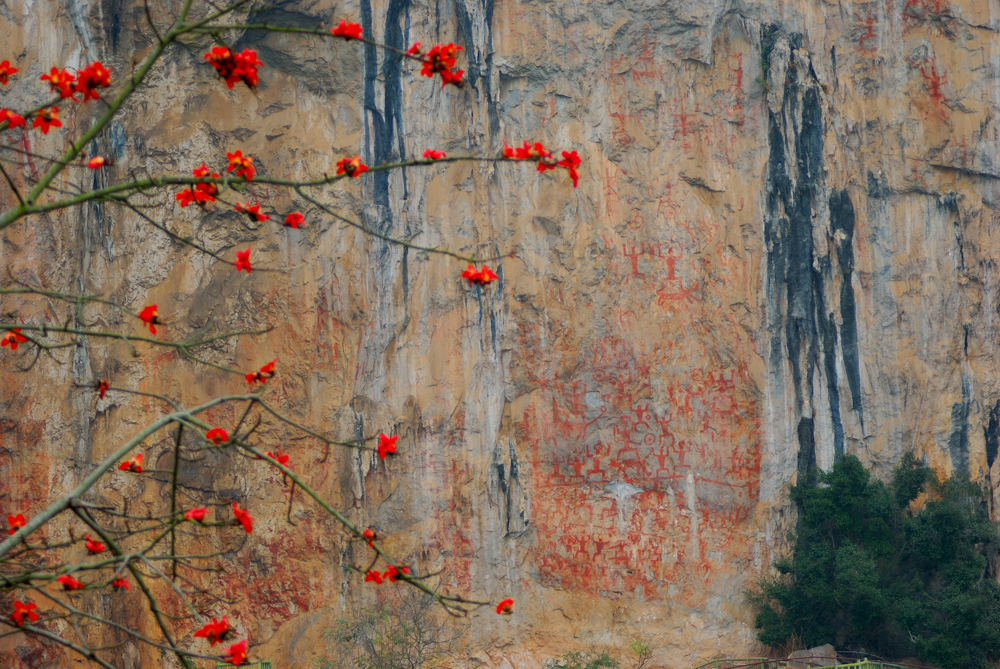


An online article by Mary-Ann Russon in International Business Times - China: Ancient Tomb of First Emperor Qin Shi Huang's Grandmother Discovered in Xi'an - reveals the ongoing excavations of a huge ancient tomb belonging to the grandmother of China's first emperor Qin Shi Huang in Xi'an, Shaanxi province, northwest China.

It was during this period that the spectacular rock art of Huashan was being painted on the limestone cliffs in the Zuojiang River valley of Guangxi Zhuang Autonomous Region.

The tomb complex covers an area measuring over 170,000 square metres , and is the second largest tomb to have ever been discovered in China.
Archaeologists have excavated two carriages and 12 horse skeletons - each carriage would have been pulled by six horses - representing royal rank and emperor status. Fragments of jade, gold and silver, have also been excavated, along with engraved pottery inscribed with the Chinese characters for Qin Shi Huang's grandmother. Her sarcophagus has not been discovered.
Qin Shi Huang was the first emperor to unify China and enact major economic and political reforms across the country. China had previously consisted of a multitude of warring states and kingdoms, each under the control of feudal overlords. After the death of Qin Shi Huang's father, he took the throne at the age of 13.
Qin Shi Huang standardised units of measurement, the length of axles of carts and currency, creating the Ban Liang coin. He also created the first unified Chinese script to make one language and communication system. Other significant legacies are the Great Wall of China and his mausoleum complex, which is also in Xi'an. The First Emperor's Tomb complex took 38 years to construct, employing over 720,000 builders. Its location was deliberately lost, hidden under the man-made Lishan Mountain, with trees and vegetation planted over it. It was discovered recently in 1974, when farmers digging wells stumbled upon the garrison of 6,000 terracotta warriors. The central tomb chamber housing the first emperor's sarcophagus has not yet been excavated, but rumours of rivers of mercury and rigged crossbows intrigue the world!
The Foundation will be launching a new section on the Zuojianng Huashan Rock Art Cultural Landscape shortly.
To visit the China Rock Art Archive:
http://www.bradshawfoundation.com/china/index.php
Comment
by Bradshaw Foundation
Monday 04 December 2023
by Bradshaw Foundation
Friday 30 June 2023
by Bradshaw Foundation
Thursday 06 April 2023
by Bradshaw Foundation
Thursday 24 November 2022
by Bradshaw Foundation
Tuesday 27 September 2022
by Bradshaw Foundation
Thursday 08 September 2022
by Bradshaw Foundation
Tuesday 19 July 2022
by Bradshaw Foundation
Monday 06 June 2022
by Bradshaw Foundation
Friday 11 March 2022
by Bradshaw Foundation
Wednesday 02 March 2022
by Bradshaw Foundation
Thursday 26 August 2021
by Bradshaw Foundation
Monday 16 August 2021
by Bradshaw Foundation
Tuesday 06 July 2021
by Bradshaw Foundation
Thursday 06 May 2021
by Bradshaw Foundation
Thursday 06 May 2021
by Bradshaw Foundation
Tuesday 16 March 2021
by Bradshaw Foundation
Monday 04 December 2023
by Bradshaw Foundation
Friday 30 June 2023
by Bradshaw Foundation
Thursday 06 April 2023
by Bradshaw Foundation
Thursday 24 November 2022
by Bradshaw Foundation
Tuesday 27 September 2022
by Bradshaw Foundation
Thursday 08 September 2022
by Bradshaw Foundation
Tuesday 19 July 2022
by Bradshaw Foundation
Monday 06 June 2022
by Bradshaw Foundation
Friday 11 March 2022
by Bradshaw Foundation
Wednesday 02 March 2022
by Bradshaw Foundation
Thursday 26 August 2021
by Bradshaw Foundation
Monday 16 August 2021
by Bradshaw Foundation
Tuesday 06 July 2021
by Bradshaw Foundation
Thursday 06 May 2021
by Bradshaw Foundation
Thursday 06 May 2021
by Bradshaw Foundation
Tuesday 16 March 2021
Friend of the Foundation











